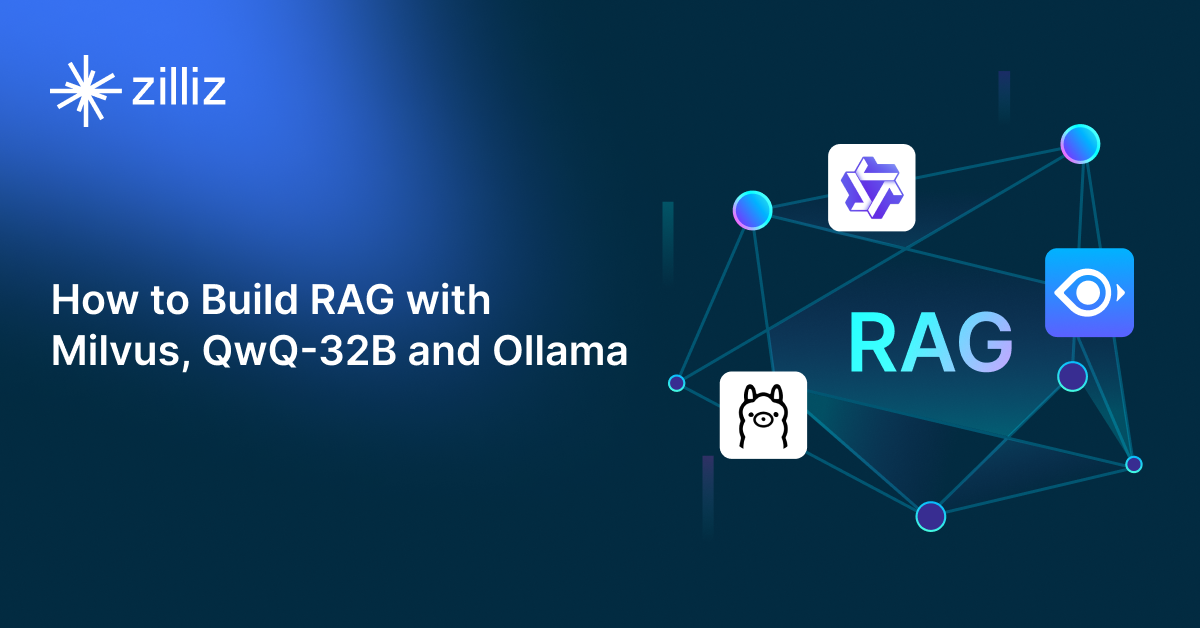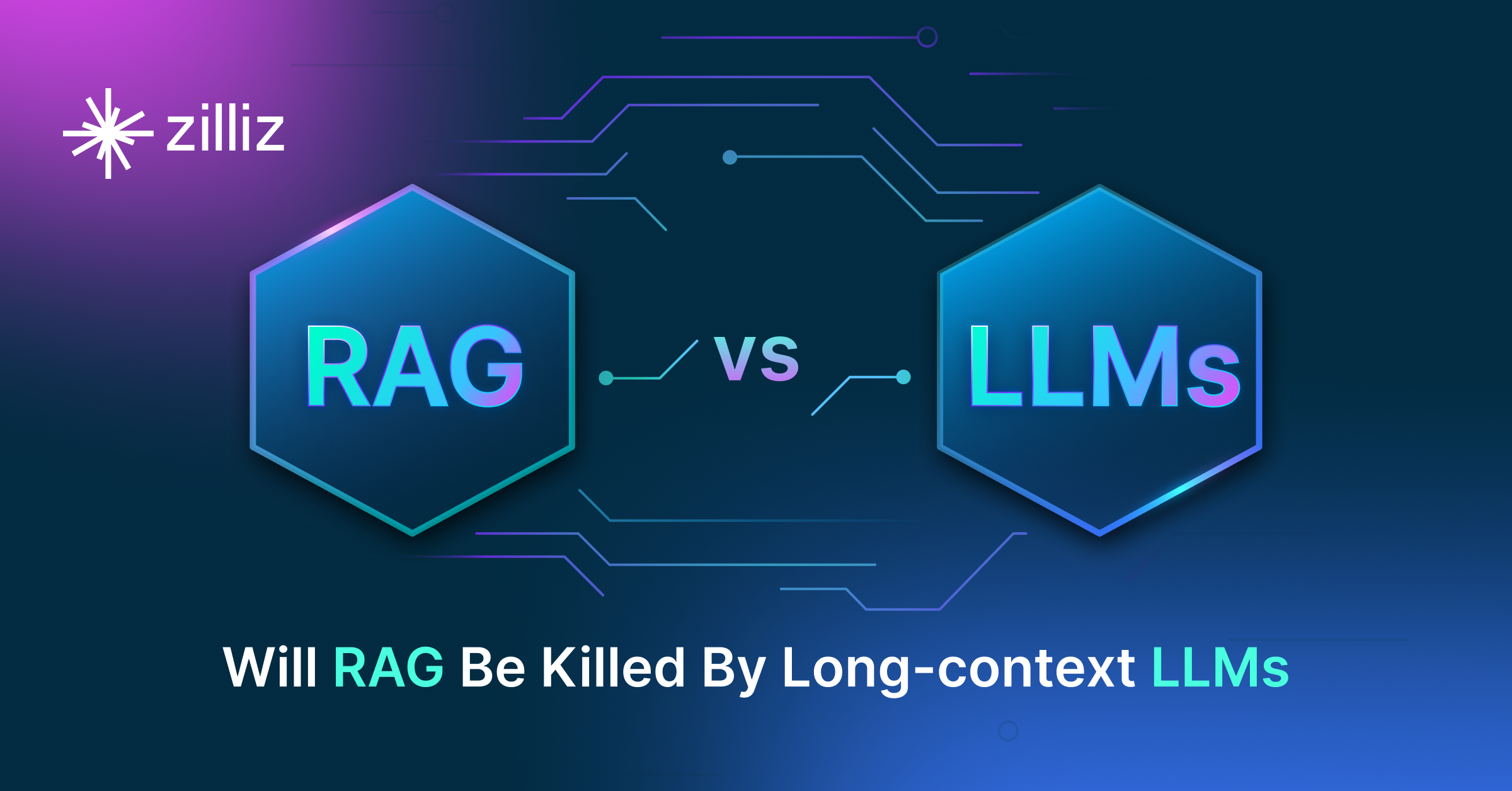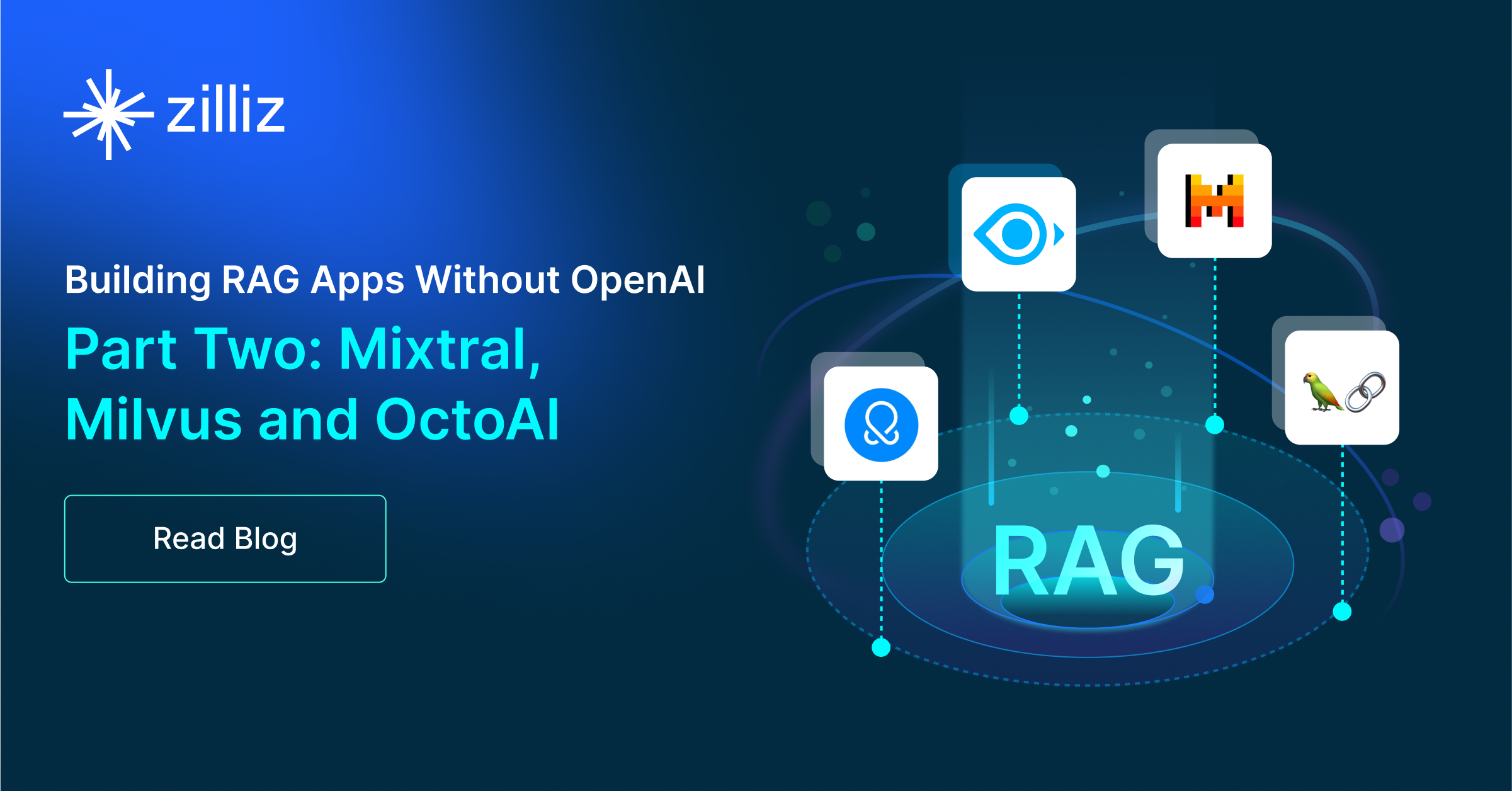Build RAG Chatbot with Haystack, Haystack In-memory store, Amazon Bedrock Claude 3.7 Sonnet, and BAAI bge-large-en-v1.5
Introduction to RAG
Retrieval-Augmented Generation (RAG) is a game-changer for GenAI applications, especially in conversational AI. It combines the power of pre-trained large language models (LLMs) like OpenAI’s GPT with external knowledge sources stored in vector databases such as Milvus and Zilliz Cloud, allowing for more accurate, contextually relevant, and up-to-date response generation. A RAG pipeline usually consists of four basic components: a vector database, an embedding model, an LLM, and a framework.
Key Components We'll Use for This RAG Chatbot
This tutorial shows you how to build a simple RAG chatbot in Python using the following components:
- Haystack: An open-source Python framework designed for building production-ready NLP applications, particularly question answering and semantic search systems. Haystack excels at retrieving information from large document collections through its modular architecture that combines retrieval and reader components. Ideal for developers creating search applications, chatbots, and knowledge management systems that require efficient document processing and accurate information extraction from unstructured text.
- Haystack in-memory store: a very simple, in-memory document store with no extra services or dependencies. It is great for experimenting with Haystack, and we do not recommend using it for production. If you want a much more scalable solution for your apps or even enterprise projects, we recommend using Zilliz Cloud, which is a fully managed vector database service built on the open-source Milvusand offers a free tier supporting up to 1 million vectors.)
- Amazon Bedrock Claude 3.7 Sonnet: A versatile multimodal AI model designed for enterprise applications, excelling in complex reasoning, code generation, and natural language tasks. Known for its balance of speed, accuracy, and cost-efficiency, it is ideal for data analysis, content creation, and scalable automation within AWS-integrated environments.
- BAAI bge-large-en-v1.5: A dense embedding model optimized for semantic retrieval, excelling in capturing nuanced text semantics for tasks like retrieval-augmented generation (RAG), semantic search, and clustering. Its strengths include high accuracy across diverse domains, robust handling of complex queries, and efficient scalability. Ideal for enterprise search engines, recommendation systems, and knowledge-intensive NLP applications requiring precise contextual understanding.
By the end of this tutorial, you’ll have a functional chatbot capable of answering questions based on a custom knowledge base.
Note: Since we may use proprietary models in our tutorials, make sure you have the required API key beforehand.
Step 1: Install and Set Up Haystack
import os
import requests
from haystack import Pipeline
from haystack.components.converters import MarkdownToDocument
from haystack.components.preprocessors import DocumentSplitter
from haystack.components.writers import DocumentWriter
Step 2: Install and Set Up Amazon Bedrock Claude 3.7 Sonnet
Amazon Bedrock is a fully managed service that makes high-performing foundation models from leading AI startups and Amazon available through a unified API. You can choose from various foundation models to find the one best suited for your use case.
To use LLMs on Amazon Bedrock for text generation together with Haystack, you need to initialize an AmazonBedrockGenerator with the model name, the AWS credentials (AWS_ACCESS_KEY_ID, AWS_SECRET_ACCESS_KEY, AWS_DEFAULT_REGION) should be set as environment variables, be configured as described above or passed as Secret arguments. Note, make sure the region you set supports Amazon Bedrock.
Now, let's start installing and setting up models with Amazon Bedrock.
pip install amazon-bedrock-haystack
from haystack_integrations.components.generators.amazon_bedrock import AmazonBedrockGenerator
aws_access_key_id="..."
aws_secret_access_key="..."
aws_region_name="eu-central-1"
generator = AmazonBedrockGenerator(model="anthropic.claude-3-7-sonnet-20250219-v1:0")
Step 3: Install and Set Up BAAI bge-large-en-v1.5
from haystack import Document
from haystack.components.embedders import SentenceTransformersDocumentEmbedder
from haystack.components.embedders import SentenceTransformersTextEmbedder
doc_embedder = SentenceTransformersDocumentEmbedder(model="BAAI/bge-large-en-v1.5")
doc_embedder.warm_up()
text_embedder = SentenceTransformersTextEmbedder(model="BAAI/bge-large-en-v1.5")
text_embedder.warm_up()
Step 4: Install and Set Up Haystack In-memory store
from haystack.document_stores.in_memory import InMemoryDocumentStore
from haystack.components.retrievers import InMemoryEmbeddingRetriever
document_store = InMemoryDocumentStore()
retriever=InMemoryEmbeddingRetriever(document_store=document_store))
Step 5: Build a RAG Chatbot
Now that you’ve set up all components, let’s start to build a simple chatbot. We’ll use the Milvus introduction doc as a private knowledge base. You can replace it your own dataset to customize your RAG chatbot.
url = 'https://raw.githubusercontent.com/milvus-io/milvus-docs/refs/heads/v2.5.x/site/en/about/overview.md'
example_file = 'example_file.md'
response = requests.get(url)
with open(example_file, 'wb') as f:
f.write(response.content)
file_paths = [example_file] # You can replace it with your own file paths.
indexing_pipeline = Pipeline()
indexing_pipeline.add_component("converter", MarkdownToDocument())
indexing_pipeline.add_component("splitter", DocumentSplitter(split_by="sentence", split_length=2))
indexing_pipeline.add_component("embedder", document_embedder)
indexing_pipeline.add_component("writer", DocumentWriter(document_store))
indexing_pipeline.connect("converter", "splitter")
indexing_pipeline.connect("splitter", "embedder")
indexing_pipeline.connect("embedder", "writer")
indexing_pipeline.run({"converter": {"sources": file_paths}})
# print("Number of documents:", document_store.count_documents())
question = "What is Milvus?" # You can replace it with your own question.
retrieval_pipeline = Pipeline()
retrieval_pipeline.add_component("embedder", text_embedder)
retrieval_pipeline.add_component("retriever", retriever)
retrieval_pipeline.connect("embedder", "retriever")
retrieval_results = retrieval_pipeline.run({"embedder": {"text": question}})
# for doc in retrieval_results["retriever"]["documents"]:
# print(doc.content)
# print("-" * 10)
from haystack.utils import Secret
from haystack.components.builders import PromptBuilder
retriever=InMemoryEmbeddingRetriever(document_store=document_store)
text_embedder = SentenceTransformersTextEmbedder(model="BAAI/bge-large-en-v1.5")
text_embedder.warm_up()
prompt_template = """Answer the following query based on the provided context. If the context does
not include an answer, reply with 'I don't know'.\n
Query: {{query}}
Documents:
{% for doc in documents %}
{{ doc.content }}
{% endfor %}
Answer:
"""
rag_pipeline = Pipeline()
rag_pipeline.add_component("text_embedder", text_embedder)
rag_pipeline.add_component("retriever", retriever)
rag_pipeline.add_component("prompt_builder", PromptBuilder(template=prompt_template))
rag_pipeline.add_component("generator", generator)
rag_pipeline.connect("text_embedder.embedding", "retriever.query_embedding")
rag_pipeline.connect("retriever.documents", "prompt_builder.documents")
rag_pipeline.connect("prompt_builder", "generator")
results = rag_pipeline.run({"text_embedder": {"text": question}, "prompt_builder": {"query": question},})
print('RAG answer:\n', results["generator"]["replies"][0])
Optimization Tips
As you build your RAG system, optimization is key to ensuring peak performance and efficiency. While setting up the components is an essential first step, fine-tuning each one will help you create a solution that works even better and scales seamlessly. In this section, we’ll share some practical tips for optimizing all these components, giving you the edge to build smarter, faster, and more responsive RAG applications.
Haystack optimization tips
To optimize Haystack in a RAG setup, ensure you use an efficient retriever like FAISS or Milvus for scalable and fast similarity searches. Fine-tune your document store settings, such as indexing strategies and storage backends, to balance speed and accuracy. Use batch processing for embedding generation to reduce latency and optimize API calls. Leverage Haystack's pipeline caching to avoid redundant computations, especially for frequently queried documents. Tune your reader model by selecting a lightweight yet accurate transformer-based model like DistilBERT to speed up response times. Implement query rewriting or filtering techniques to enhance retrieval quality, ensuring the most relevant documents are retrieved for generation. Finally, monitor system performance with Haystack’s built-in evaluation tools to iteratively refine your setup based on real-world query performance.
Haystack in-memory store optimization tips
Haystack in-memory store is just a very simple, in-memory document store with no extra services or dependencies. We recommend that you just experiment it with RAG pipeline within your Haystack framework, and we do not recommend using it for production. If you want a much more scalable solution for your apps or even enterprise projects, we recommend using Zilliz Cloud, which is a fully managed vector database service built on the open-source Milvusand offers a free tier supporting up to 1 million vectors
AmazonBedrock Claude 3.7 Sonnet optimization tips
Optimize Claude 3.7 Sonnet in RAG by preprocessing data to remove noise, using semantic chunking (512-1024 tokens) with overlap for context continuity. Adjust temperature (0.3–0.6 balances creativity) and max_tokens to control response length. Structure prompts with clear instructions and retrieval context placement. Cache frequent queries and embeddings to reduce latency. Apply metadata filters during retrieval to improve relevance. Monitor precision/recall via built-in metrics and tweak retrieval thresholds. Use batch inference for cost efficiency and parallelize document processing. Test varying chunk sizes, top-k retrievals, and system prompts to balance accuracy, speed, and operational costs.
BAAI bge-large-en-v1.5 optimization tips
To optimize BAAI bge-large-en-v1.5 in RAG, ensure input text is clean and preprocessed (remove noise, truncate to 512 tokens). Use the model’s instruction prefix ("Represent this sentence for retrieval: ") for query embeddings to align with its training. Batch embedding generation for efficiency, and normalize outputs before similarity comparisons. Fine-tune on domain-specific data if retrieval accuracy lags. Use FAISS or HNSW for fast vector search, and quantize embeddings to reduce memory. Regularly evaluate recall@k to balance speed and relevance. Leverage GPU acceleration and optimize temperature/sampling for generation coherence.
By implementing these tips across your components, you'll be able to enhance the performance and functionality of your RAG system, ensuring it’s optimized for both speed and accuracy. Keep testing, iterating, and refining your setup to stay ahead in the ever-evolving world of AI development.
RAG Cost Calculator: A Free Tool to Calculate Your Cost in Seconds
Estimating the cost of a Retrieval-Augmented Generation (RAG) pipeline involves analyzing expenses across vector storage, compute resources, and API usage. Key cost drivers include vector database queries, embedding generation, and LLM inference.
RAG Cost Calculator is a free tool that quickly estimates the cost of building a RAG pipeline, including chunking, embedding, vector storage/search, and LLM generation. It also helps you identify cost-saving opportunities and achieve up to 10x cost reduction on vector databases with the serverless option.
 Calculate your RAG cost
Calculate your RAG cost
What Have You Learned?
Wow, you’ve just journeyed through the exciting process of building a RAG system from the ground up! By now, you’ve seen how Haystack acts as the backbone, seamlessly connecting components into a cohesive pipeline. You learned to use the Haystack In-Memory Store for lightning-fast data retrieval, ensuring your system accesses relevant information in real time. Then came Amazon Bedrock’s Claude 3.7 Sonnet, the powerhouse LLM that transforms retrieved data into insightful, human-like responses. And let’s not forget the BAAI bge-large-en-v1.5 embedding model, which turned your raw data into rich numerical representations, making semantic search possible. Together, these tools showed you how to create a system that doesn’t just answer questions but understands context—like giving your app a supercharged brain!
But wait, there’s more! The tutorial didn’t stop at basics. You picked up pro tips for optimizing performance, like tweaking chunk sizes and refining prompts to squeeze every drop of potential from Claude. Plus, the free RAG cost calculator gave you a practical way to balance accuracy and budget—because smart scaling matters. Now imagine what’s next: customizing this pipeline for your niche, experimenting with hybrid search, or even integrating multimedia. The possibilities are endless, and you’re armed with the tools to chase them. So why wait? Dive in, tweak that code, and watch your ideas come alive. Your RAG-powered future is just a few lines away—build boldly, optimize fearlessly, and let your creativity run wild. The world needs your next big idea, and you’re ready to build it! 🚀
Further Resources
🌟 In addition to this RAG tutorial, unleash your full potential with these incredible resources to level up your RAG skills.
- How to Build a Multimodal RAG | Documentation
- How to Enhance the Performance of Your RAG Pipeline
- Graph RAG with Milvus | Documentation
- How to Evaluate RAG Applications - Zilliz Learn
- Generative AI Resource Hub | Zilliz
We'd Love to Hear What You Think!
We’d love to hear your thoughts! 🌟 Leave your questions or comments below or join our vibrant Milvus Discord community to share your experiences, ask questions, or connect with thousands of AI enthusiasts. Your journey matters to us!
If you like this tutorial, show your support by giving our Milvus GitHub repo a star ⭐—it means the world to us and inspires us to keep creating! 💖
- Introduction to RAG
- Key Components We'll Use for This RAG Chatbot
- Step 1: Install and Set Up Haystack
- Step 2: Install and Set Up Amazon Bedrock Claude 3.7 Sonnet
- Step 3: Install and Set Up BAAI bge-large-en-v1.5
- Step 4: Install and Set Up Haystack In-memory store
- Step 5: Build a RAG Chatbot
- Optimization Tips
- RAG Cost Calculator: A Free Tool to Calculate Your Cost in Seconds
- What Have You Learned?
- Further Resources
- We'd Love to Hear What You Think!
Content
Vector Database at Scale
Zilliz Cloud is a fully-managed vector database built for scale, perfect for your RAG apps.
Try Zilliz Cloud for Free


